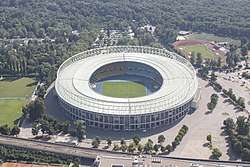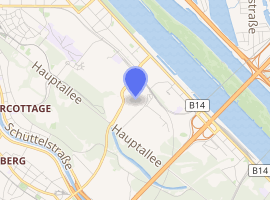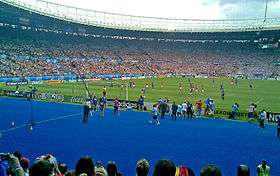Ernst-Happel-Stadion
The Ernst-Happel-Stadion (![]()
 UEFA | |

| |
| Former names | Praterstadion (1931–1992) |
|---|---|
| Location | Meiereistraße 7, Vienna, Austria |
| Coordinates | 48°12′25.8″N 16°25′13.9″E |
| Owner | City of Vienna |
| Operator | Wiener Stadthalle Betriebs- und Veranstaltungsgesellschaft m.b.H. |
| Type | UEFA Category 4 Stadium |
| Capacity | 50,865[1] (end-stage) 68,500 (center-stage) |
| Record attendance | 90,726 (Austria-Spain, 30 October 1960) |
| Field size | 105 m × 68 m (344 ft × 223 ft) |
| Construction | |
| Broke ground | 1929 |
| Built | 1929–1931 |
| Opened | 11 July 1931 |
| Renovated | 1986 |
| Architect | Otto Ernst Schweizer |
| Tenants | |
| Austria national football team | |
The stadium is owned by the City of Vienna (Municipal Department 51 – Sports of the City of Vienna). It is managed by the Wiener Stadthalle Betriebs und Veranstaltungsgesellschaft m.b.H., a subsidiary of Wien Holding. It is a UEFA Category 4 stadium, and as such, it is the home of the Austrian national team. It also hosts the Viennese clubs' games in Europa League.
The stadium is served by Stadion station on the U2 metro line.
History
1928–1945
The foundation stone was laid in November 1928 in honor of the 10-year celebration of the Republic of Austria. The stadium was constructed in 23 months, from 1929 to 1931. It was built according to a design by the Tübingen architect Otto Ernst Schweizer and the second Workers' Olympiad. Schweizer also designed the adjacent Stadionbad (with 400,000 sq m, Europe's largest swimming pool). According to its location in Vienna's Prater, it was initially named Prater Stadium. It was a modern stadium at the time, particularly in Europe, because of its short discharge time of only 7 to 8 minutes. Initially the stadium had a capacity of approximately 60,000 people.
During the National Socialist Era following Anschluss, (1938–1945) the stadium was used as a military barracks and staging area and as a temporary prison for the deportation of Jewish citizens.[2] Between September 11 and 13, 1939, after the attack on Poland, over a thousand Polish-born Viennese Jews were detained on the orders Reinhard Heydrich. They were imprisoned beneath the grandstands in the corridors of Section B. On September 30, 1,038 prisoners were deported to the Buchenwald concentration camp. The next day, the stadium was back to being used for a football match. 44 men were released in early 1940, 26 were freed in 1945, the rest were murdered in the camps. In 1988, one of the surviving victims, Fritz Klein, was awarded a compensation by the Austrian government equivalent to 62,50 euros for being detained in the stadium. In 2003 a memorial plaque, commemorating these events, was unveiled in the VIP area by a private initiative. In 1944, the stadium was severely damaged during a bomb attack on the Wehrmarcht Staff offices.
1945–2000
After the war and the reconstruction of the stadium, it was again sporting its original use. In 1956, the stadium's capacity was expanded to 92,708 people by Theodor Schull, but in 1965 the capacity was reduced. The attendance record was 91,000 spectators set on October 30, 1960 at the football match between Spain and Austria (0–3).
In the mid-1980s, the stands were covered and fully equipped with seats. At its reopening a friendly match against archrivals Germany was organised. Austria won the match 4–1. After the death of former Austrian top player and coach Ernst Happel, the Prater Stadium was renamed after him in 1992. In 1964, 1987, 1990, and 1995, the Ernst Happel Stadium was the venue of the European Cup/UEFA Champions League final.
In 1970, the stadium was the venue of the 1970 European Cup Winners' Cup Final which saw Manchester City F.C. beat Górnik Zabrze by 2 goals to 1 in an entertaining match. Neil Young and a Francis Lee penalty sealed the win for City. This final was played under torrential rain in what was then an uncovered stadium. This along with the fact no Polish supporters were allowed to travel to the match restricted the attendance, which is variously reported at between 7,900 and 15,000 spectators. Even so, City's travelling support numbered over 4,000 which was a then record for an English club playing on the continent.
UEFA Euro 2008
During the UEFA Euro 2008 tournament, the Ernst Happel Stadium was the venue for the Final match. Previously, the three group matches of the Austrian National Team, two quarter finals and a semifinal match took place in the stadium. In preparation for the tournament, the first and second place additional rows of seats increased the stadium's capacity to 53,000 seats.
Leading up to the tournament, it was fitted with a heated pitch in the summer of 2005. In May 2008, a connection to the Vienna U-Bahn was established, easing access from all over the city. The cost of the rebuilding was €39,600,000.
The following games were played at the stadium during the UEFA Euro 2008:
| Date | Time (CET) | Team #1 | Result | Team #2 | Round | Spectators |
|---|---|---|---|---|---|---|
| 8 June 2008 | 18.00 | 0–1 | Group B | 51,428 | ||
| 12 June 2008 | 20.45 | 1–1 | Group B | 51,428 | ||
| 16 June 2008 | 20.45 | 0–1 | Group B | 51,428 | ||
| 20 June 2008 | 20.45 | 1–1 aet (1–3 pen.) | Quarter-finals | 51,428 | ||
| 22 June 2008 | 20.45 | 0–0 aet (4–2 pen.) | Quarter-finals | 48,000 | ||
| 26 June 2008 | 20.45 | 0–3 | Semi-final | 51,428 | ||
| 29 June 2008 | 20.45 | 0–1 | Final | 51,428 |
Football
The Ernst Happel Stadium is the largest football stadium in Austria. It is the home of the Austrian national football team. Club football matches are generally limited to the domestic cup final and international competitions featuring one of Vienna's top clubs, FK Austria Wien and SK Rapid Wien, as their regular stadiums are too small to host UEFA Champions League and UEFA Cup matches. Vienna derby matches between FK Austria and SK Rapid have also been played in the stadium.
The stadium is rated one of UEFA's Five Star Stadiums permitting it to host the UEFA Champions League final. The seating capacity was temporarily expanded to 53,008[3] for the UEFA Euro 2008 championship, with the final played in the stadium. The stadium also hosted 3 group games, 2 quarter-final matches, a semi-final and final. The attendance record of 92,706 for the match against the Soviet Union was in 1960.[4] The capacity has since been reduced.
Notable matches held in the stadium
- 1964 European Cup Final: Internazionale 3–1 Real Madrid
- 1970 European Cup Winners' Cup Final: Manchester City 2–1 Górnik Zabrze
- 1987 European Cup Final: Porto 2–1 Bayern Munich
- 1990 European Cup Final: Milan 1–0 Benfica
- 1994 UEFA Cup Final: Internazionale 1–0 Austria Salzburg
- 1995 UEFA Champions League Final: Ajax Amsterdam 1–0 Milan
- UEFA Euro 2008 Final: Spain 1–0 Germany
Other sports
Other sporting events are held in the stadium, including athletics, cycling and tennis. In 1950, 35,000[5] watched Austrian Josef Weidinger win the European Heavyweight crown against Stefan Olek (of France), and a temporary pool in the stadium was the venue for the 1995 European LC Championships.
On July 16, 2011, the American Football World Championship final took place where USA defeated rivals Canada with a score of 50–7 in front of 20,000 spectators.
In June 6 and 7, 2014, the three game of the final stage of the 13th European Championship of American Football took place in this stadium.
Concerts
References
- https://www.uefa.com/MultimediaFiles/Download/FirstDiv/uefaorg/Publications/01/67/03/93/1670393_DOWNLOAD.pdf
- "Happel Stadium hides a sinister past". Archived from the original on 2008-06-29.
- "Vienna City Government website". Archived from the original on 2008-06-16. Retrieved 2007-06-29.
- "Vienna City Government website". Archived from the original on 2007-09-29. Retrieved 2007-06-29.
- "Vienna City Government website". Archived from the original on 2007-09-29. Retrieved 2007-06-29.
- "Billboard Boxscore :: Current Scores". Billboard. Archived from the original on July 25, 2017. Retrieved July 26, 2017.
- "57,000 visitors celebrate Pink in Vienna at "DiePresse.com". vaaju. Retrieved July 25, 2019.
- "Khalid Flies to New Heights With $30 Million On Free Spirit World Tour". Billboard. September 20, 2019. Retrieved September 20, 2019.
| Events and tenants | ||
|---|---|---|
| Preceded by Wembley Stadium London |
European Cup Final venue 1964 |
Succeeded by San Siro Milan |
| Preceded by St. Jakob Stadium Basel |
European Cup Winners' Cup Final venue 1970 |
Succeeded by Karaiskakis Stadium Athens |
| Preceded by Estadio Ramón Sánchez Pizjuán Seville |
European Cup Final venue 1987 |
Succeeded by Neckarstadion Stuttgart |
| Preceded by Camp Nou Barcelona |
European Cup Final venue 1990 |
Succeeded by Stadio San Nicola Bari |
| Preceded by Olympic Stadium Athens |
UEFA Champions League Final venue 1995 |
Succeeded by Stadio Olimpico Rome |
| Preceded by Estádio da Luz Lisbon |
UEFA European Championship Final venue 2008 |
Succeeded by NSC Olimpiyskiy Kiev |
| Preceded by Todoroki Athletics Stadium Kawasaki |
IFAF World Championship Final venue 2011 |
Succeeded by Tele2 Arena Stockholm |
